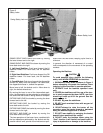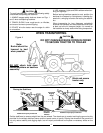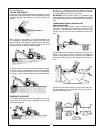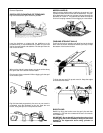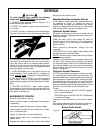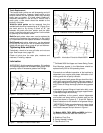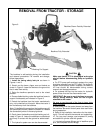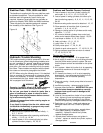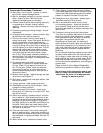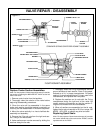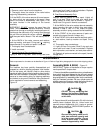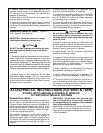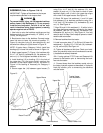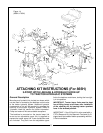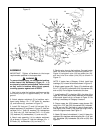
Stabilizer Pads - 765H, 865H and 965H
The backhoe is supplied with flip-over stabilizer pads
as standard equipment. They are suitable for most
backhoe work and generally are all that is ever
required. However, street pad kits are available as
options for Models 765H, 865H and 965H backhoes.
These kits bolt to the standard pads and increase
the versatility of the backhoe. See Figure 10.
Hydraulic Trouble Shooting
The trouble shooting material presented in this sec-
tion is offered as a guide to diagnosing probable caus-
es and remedies for general operational problems.
Match your problem with the typical problem exam-
ples given, and note the numbers given for the possi-
ble cause. These numbers correspond with the possi-
ble cause and correction paragraphs that follow.
NOTE: When using the following chart, if it is decided
that an overhaul of components or pressure adjust-
ments are necessary to correct malfunctioning, it is
recommended that your dealer make these repairs.
He is equipped to do this work.
WARNING
Escaping hydraulic / diesel fluid under pressure
can penetrate the skin causing serious injury.
Do not use your hand to check for leaks. Use a
piece of cardboard or paper to check for leaks.
Stop engine and relieve pressure before connect-
ing or disconnecting lines.
Tighten all connections before starting engine or
pressurizing lines.
If any liquid is injected into the skin, obtain med-
ical attention immediately or gangrene may result.
Problems and Possible Causes
A. Machine fails to operate when started initially - 1,
2, 5, 7, 16, 24
B. Machine loses power after operating satisfactorily
initially - 1, 8, 10, 14, 16, 24
C. Loss of power in lift or crowd cylinder, but other
cylinders function properly - 23, 25, 30
17
Problems and Possible Causes, Continued
D. Loss of power in any one cylinder including lift
and crowd - 8, 9, 10, 11, 12, 13, 23, 25, 26
E. Loss of power in swing cylinders, but other cylin-
ders functioning properly - 8, 9, 10, 11, 12, 13, 23,
24, 26
F. Maximum swing action cannot be obtained - 12, 15
G. Slow operation of machine (lack of power) all
cylinders - 1, 4, 6, 14, 16, 24
H. Spongy or jerking action of cylinders and/or noisy
operation - 1, 3, 4, 5
I. Lift, crowd or bucket cylinders drop under load
when control spools shifted from neutral - 28, 30
J. Load drops or settles - 8, 10, 13, 26, 28
K. Leaky cylinders - 10, 11, 12, 13
L. Leaky valve - 8, 16, 17, 29
M. Sticky valve spool - 17, 20, 21, 22
N. Unable to push valve spool in - 17, 18, 20, 21, 22
O. Spring centered spools do not return to neutral -
17, 18, 19, 20, 21, 22
Causes and Corrections
1. Low oil supply in reservoir - fill to proper level.
2. No oil supply to machine - oil is not being diverted
from the prime mover hydraulic system. Be sure
that the proper controls are actuated on the prime
mover.
3. Air in system - bleed all circuits of air by operating
machine at maximum oil flow and through full
movements.
4. Oil viscosity too heavy, or oil is not at operating
temperature - use recommended hydraulic fluid.
Run machine until oil reaches operating
temperature.
5. Pump not running - check pump drive to be sure it
is engaged.
6. Insufficient pumping - advance engine throttle.
7. Improper hose connection - IMPORTANT: Be sure
inlet and return hoses are hooked up correctly.
Improper hook-up will result in damage to the
backhoe valve.
8. Loose oil line connections, leaks in line or broken
lines - tighten all hose connections and replace
any damaged O-rings at leaking O-ring fittings.
Check and replace any damaged hoses and lines.
9. Restrictions in oil lines - check and replace any
damaged hoses and lines. Check for pinched
hoses.
10. Oil is bypassing cylinder piston, scored piston,
worn piston packing, or defective piston
assembly - replace or rebuild the cylinder;
replace damaged parts.
11. Scored piston rods and worn rod guides in
cylinder - replace or rebuild the cylinder; replace
damaged parts.
Continued
Figure 10



